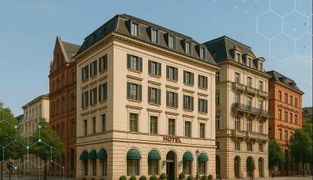Similar to buying a car, where the cost depends on its features, the price of hotel software goes beyond the initial investment. As the owners strive to improve operations and guest satisfaction, they inevitably wonder: What's the real cost of a PMS?
In this article, we'll explore all associated costs of property management systems in the year 2026. From initial costs to hidden setup fees, we'll shed light on what you need to know.
What a Property Management System really is?
A Property Management System (or PMS) is the backbone of hotel operations that enables efficient management of administrative tasks and reservations on your computer.

Such systems are all different and have their distinct features, advantages, and target markets. But when it comes to the core functionalities, in most cases they include:
- ● Reservation module
- ● Front office module (for efficient hotel check-ins and check-outs)
- ● Booking Engine
- ● Channel Manager
- ● Revenue management
- ● Customer Relationship Management (CRM)
- ● Housekeeping
- ● Point of Sale (POS)
- ● …and more
Initially, you might think these features are all you're paying for. But a great PMS goes beyond these basics.
While well-designed modules are essential, what truly distinguishes a good hotel management system is the support infrastructure behind it. A responsive customer care team, availability of employee training, and regular system updates are vital components of a seamless user experience.
Plus, it's handy if your PMS can work with other apps you use daily, like door locks or self-service kiosks. Suddenly, it's not just about features—it's about a solution that perfectly fits your business needs.
PMS Cost Calculator
Our interactive PMS cost calculator allows you to quickly estimate the cost of a Property Management System tailored to your hotel’s specific needs. Simply enter the specifications for your property or the features you’re considering for a PMS.
For more guidance on choosing hotel software, check out our quick guide: What is a hotel PMS? How to find the best software.
Factors influencing the cost of a hospitality management system
But all this convenience comes at a cost. Constantly maintaining and updating a complex system requires resources, which is reflected in its price tag.
Here, you need to think of it as an investment. By choosing a top-notch PMS, you're setting yourself up for smoother operations and ultimately—a high ROI in the long run.
Do not worry, it won’t cost you a fortune. We decided to look closely at why prices for some property management systems are higher than for others, and here is what we found out.
The price of a PMS can vary from tens to thousands of dollars per month and largely depends on the following factors:
Size and scale of the property
The number of rooms, the complexity of operations, and the overall scale of the property directly impact the cost. Larger properties with more rooms and complex operations usually require higher-tiered plans or custom features.
A simple PMS usually costs around €40-€50 per month and goes up as your occupancy or number of rooms increases. Meanwhile, more advanced PMS options begin at approximately €200-€300 per month for smaller properties and increase based on occupancy or room count.
Features and functionalities required
The “breadth and depth” of features needed by the hotel are other important components.

Basic PMS packages offer core functionalities like reservation management and billing, while advanced features such as spa management or event planning may come at an additional fee.
If your business requires some major adjustments to the software—let’s say, to add several custom types of reports or reorganize the system’s structure in some way, it also adds to the price.
But, for instance, implementing a white-label hotel app may be considered an extra project, typically billed on a per-development-hour basis. At HotelFriend, we undertook such a project for an amazing apartment complex in Engelberg, creating the A&A Concierge white label application.
Today, guests at the complex benefit from in-app check-in and check-out, make immediate payments for services, and book rooms directly from their mobile devices. The app also helps guests to access their rooms and open the fridge via smartphone.
To learn more about this project and its impact on guest-focused hospitality, take a look at our case study: A&A Liegenschaften-group story: The ultimate digital success formula for guest-focused hospitality.

Deployment model (Cloud-based vs. On-premise)
The deployment model chosen—on-premise or cloud-based—affects cost considerations the most.
Locally hosted PMS, or on-premises systems, often come with a substantial upfront investment, including hardware procurement and installation costs. Moreover, ongoing expenses such as maintenance, upgrades, and IT personnel salaries contribute to higher total ownership costs over time.
Cloud-based PMS, on the other hand, typically operate on a subscription-based pricing model, offering more flexibility in terms of scalability and payment structure. Users pay a recurring fee based on usage, which may include factors such as the number of properties managed, the volume of transactions processed, and the level of support required.
Cloud-based solutions often remove the need for expensive hardware upgrades and maintenance since the service provider takes care of these tasks.
Integration capabilities with other systems
Integration with existing systems like point-of-sale (POS), customer relationship management (CRM), and accounting software is crucial for seamless operations.
PMS solutions offering extensive integration capabilities may have higher initial costs but can lead to long-term efficiency gains.
Connection of Channel Management systems also incurs a regular fee, similar to other third-party services. Most Channel Manager providers offer a simple pricing model based on the hotel's room count. For smaller hotels, the monthly cost might start at just €9.99, increasing as the number of rooms grows.
The most popular pricing models
Typically, property management software is offered under one of three main pricing models: monthly payment per room, tiered pricing, or a one-time license.
To gain a deeper insight into the cost of property management software, let's explore these three primary pricing structures. We’ll also give you some concrete examples of vendors and review the price range for each model.
● Monthly payment per room
This pricing model charges a monthly fee based on the number of rooms or units the PMS manages. It offers a straightforward and scalable approach, aligning costs with business growth.
Hotels with fluctuating occupancy rates or those undergoing seasonal variations often find this model beneficial, as they only pay for the resources they use. You can find the cheapest property management software within this variant.
Still, it's essential to consider the potential for increased expenses as your property grows, as each additional room brings incremental costs.
Price range: Typically ranges from a few euros to tens of euros per room per month, depending on the features and provider.
Example: HotelFriend, with pricing starting at €6.40 per room/month.
● Tiered pricing
The tiered pricing model categorizes properties into different tiers or levels based on factors such as size, features, or usage volume. Each tier corresponds to a predefined set of functionalities and pricing. This pricing model may also overlap with the pay-per-room variant.
This option provides flexibility, allowing businesses to select a tier that aligns with their requirements and budget constraints. Smaller establishments may opt for basic tiers with essential features, and larger properties can access advanced functionalities by choosing higher tiers.
The possible drawback is—you need to assess whether the features included in your tier align with your property's needs to avoid overpaying for unnecessary capabilities.
Price range: Starts from a basic package with essential features to higher tiers with advanced functionalities, with prices ranging from a few hundred to several thousand euros per month.
Example: Cloudbeds PMS, with its tiered pricing starting at €95 per month.
● One-time license
Unlike subscription-based models, the one-time license pricing model involves a single upfront payment to acquire the PMS software permanently.
This model appeals to businesses seeking long-term cost savings and greater control over their software assets. However, you should remember that one-time license fees typically entail higher initial investments compared to other subscriptions.
Additionally, ongoing maintenance and support may incur additional charges, necessitating careful consideration of the total cost of ownership over the software's lifecycle.
Price range: Typically higher upfront costs range from a few thousand to tens of thousands of euros, depending on the size and complexity of the property.
Examples: According to Capterra, the one-time price for Oracle OPERA Cloud PMS for Hotel Property Management starts from €14000, and may go up to almost €250000.
● Custom options
In addition to the primary pricing models mentioned above, some PMS vendors offer personalized pricing tailored to the unique needs and preferences of each business.
This approach allows hotels to negotiate pricing based on desired features, scale of operations, or integration requirements
Opting for a custom pricing plan is surely beneficial for properties that may not fit neatly into standard pricing models.
Revealing the surface and hidden costs of a PMS
While some vendors provide cost calculators on their websites for transparent pricing, you need to remember that there are often undisclosed expenses, like installation and training.
|
In addition to the monthly fee per unit, consider such typical expenses as: |
|
Ensuring that staff is properly trained on how to use your brand-new PMS is vital for maintaining business continuity. It's also necessary to factor in any additional hardware needed to support your PMS, so these services should always be included in your cost considerations.
|
In addition to the obvious expenses, there are often hidden costs that catch hoteliers off guard: |
|
Some PMS vendors may charge for technical support beyond basic assistance, such as customization or troubleshooting specific issues.
Depending on the jurisdiction and specific regulatory requirements, compliance-related costs, such as implementing tax compliance solutions are another thing to keep in mind.
A closer look at calculating costs for different hotels
When hotel owners set out to find the perfect PMS, its end price is always a mystery. As it was mentioned, you've got to consider both the one-time setup fees and the ongoing monthly payments.
Let's break all the costs down with a couple of hypothetical scenarios, taking HotelFriend pricing as an example.
Scenario 1: Small boutique hotel with 10 rooms
Running a small hotel often means wearing many hats every day with less staff and a tight budget. For businesses like this, it's important to choose a PMS that fits their needs without extra costs for unnecessary features. If you have a lower margin, paying for features you don't need can significantly affect your financial performance.
With 10 rooms, such a hotel would prioritize simplicity and efficiency in its operations. In this case, basic features are enough to manage day-to-day tasks effectively.
Monthly costs |
Hotel Software: At €8 per room/month, the total monthly fee amounts to €80, covering essential features such as a cloud-based PMS with drag-and-drop Front Desk, Guest Management, Room management, Staff management, Housekeeping, and Reporting. |
One-time costs |
Booking Engine Setup: A €200 fee to secure seamless integration with the hotel's website. Initial Hotel Setup: For a one-time fee of €400, the PMS provider completes a full establishment of PMS infrastructure. Data Import: Transferring existing data incurs a one-time cost of €250 per dataset, ensuring a smooth transition to the new platform. Employee Training: Investing €400 in 2-4 hours of comprehensive training equips staff with the necessary skills to leverage the PMS effectively. |
Total estimate: A one-time payment of €1250 + recurring payments of around €80 per month
Scenario 2: Upscale сity hotel with 180 rooms
An advanced PMS system is indispensable for larger hotels. With bookings coming from diverse channels and a continuous influx of guests, it is essential for effectively managing everyday challenges. This software streamlines hotel operations by minimizing administrative tasks and preventing booking conflicts.
For instance, consider a hotel with 180 rooms that welcomes different types of guests, from vacationers to business travelers. Because of its size, this hotel needs advanced features in its PMS system, like a Channel Manager, Booking Engine, POS, and Accounting tools, to keep everything running without a hitch.
Monthly costs |
Hotel Software: Priced at €12.50 per room/month, the comprehensive PMS solution amounts to €2,250 monthly, encompassing features tailored to its expansive operations. POS System Integration: Enhancing F&B operations with integrated Point-of-Sale functionality entails a monthly expense of €50. |
One-time costs |
Initial Hotel Setup: Configuring the PMS for a large-scale operation requires a one-time investment of €800 to ensure seamless deployment. Channel Manager Setup: Facilitating connectivity with multiple distribution channels incurs a one-time fee of €99. Booking Engine setup: €200 to optimize direct bookings and improve guest experience. Data Import: Similar to the smaller establishment, data migration incurs a one-time cost of €250 per dataset. Employee Training: Equipping a sizable workforce with the requisite skills includes a one-time investment of €400 for tailored training sessions. |
Total estimate: A one-time payment of €1749 + recurring payments of around €2300 per month.
As exemplified by this scenario, large organizations often need extensive customization to align the PMS with their workflows and unique requirements.
This can significantly impact the overall cost, as it may involve additional development work, integration efforts, or tailored training programs.
Note: The calculations provided are approximate and serve as a general guideline. Actual prices may vary based on negotiation, specific requirements, additional services needed, and ongoing support agreements.
Top 5 tips for cost-effective PMS selection
In this section of our guide, we'll provide practical advice designed specifically for hoteliers. We've condensed five key strategies to help you select a PMS wisely.
Tip 1 |
Step back to assess your property’s specific needs |
Every hotel has unique requirements influenced by its size, location, target market, and existing infrastructure. Identify the functions essential for streamlining your operations and enhancing guest experiences. Understanding your needs upfront helps you narrow down options and avoid unnecessary expenses. |
Tip 2 |
Compare different vendors |
Once you've clarified your requirements, conduct a thorough vendor comparison. Examine features offered by different PMS providers and make sure they align with your already identified needs. Scrutinize their pricing structures to understand the logic of pricing. Check customer reviews to assess the level of satisfaction of your peers. |
Tip 3 |
Choose a scalable solution |
The growth of a successful business is always inevitable. Select a PMS that is capable of supporting your future expansion. Ensure the system can scale alongside your business, adapting to increases in property size, guest volume, and operational complexity. Scalability guarantees that your investment remains viable in the long term. |
Tip 4 |
Estimate the Total Cost of Ownership (TCO) |
Beyond upfront costs, try to calculate the total cost of ownership (TCO) for your hotel management system. Account for implementation, training, maintenance, and potential upgrade expenses. Evaluating TCO provides a comprehensive view of financial implications, aiding informed decision-making aligned with budgetary constraints. |
Tip 5 |
Prioritize integration capabilities |
Seamless integration with essential systems like point-of-sale, online booking engines, and accounting software is vital for operational efficiency. Choose a PMS offering robust integration options or APIs for smooth data flow and unified experiences across platforms, minimizing fragmented experiences. |
Conclusion
Picking the right Property Management system for your B&B, apartment, or hotel chain goes beyond finding the cheapest price. It's about finding a solution that fits your needs and long-term plans.
To make the right decision, start by evaluating your business requirements, compare various vendors and the solutions they offer, prioritize scalability and integration capabilities, and carefully assess the total cost of ownership throughout the system's lifespan.
We hope this pricing guide can help you steer clear of common mistakes when choosing new software and understand your tech costs better.





